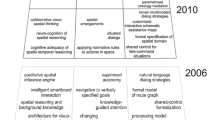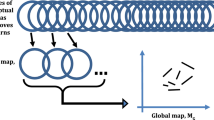Abstract
The paper gives a brief overview of the interdisciplinary DFG priority program on spatial cognition and presents one specific theme which was the topic of a recent workshop in Göttingen in some more detail. A taxonomy of landmark, route, and survey knowledge for navigation tasks proposed at the workshop is presented. Different ways of acquiring route knowledge are discussed. The importance of employing different spatial reference systems for carrying out navigation tasks is emphasized. Basic mechanisms of spatial memory in human and animal navigation are presented. After outlining the fundamental representational issues, methodological issues in robot and human navigation are discussed. Three applications of spatial cognition research in navigation tasks are given to exemplify both technological relevance and human impact of basic research in cognition.
The priority program on spatial cognition by the Deutsche Forschungsgemeinschaft currently supports 15 interdisciplinary research projects at 13 research institutions (http://www.informatik.uni-hamburg.de/Raum).
Access this chapter
Tax calculation will be finalised at checkout
Purchases are for personal use only
Preview
Unable to display preview. Download preview PDF.
Similar content being viewed by others
References
Cartwright, B.A. & Collett, T.S. (1982). How honey bees use landmarks to guide their return to a food source. Nature, 295, 560 – 564.
Cohen, G. (1989). Memory in the real world. Hove: Erlbaum.
Collett, T.S. & Baron, J. (1995). Learnt sensori-motor mappings in honeybees: interpolation and its possible relevance to navigation. J. comp. Physiol. A, 177, 287 – 298.
Franklin, N., Tversky, B. & Coon, V. (1992). Switching points of views in spatial mental models. Memory & Cognition, 20, 507 – 518.
Franz, M.O., Schölkopf, B., Georg, P., Mallot, H.A., & Bülthoff, H.H. (1997). Learning view graphs for robot navigation. In Proc. 1. Intl. Conf. onAutonomous Agents, 1997.
Freksa, C. & Habel, C. (1990). Representation and Verarbeitung räumlichen Wissens. Berlin: Springer.
Gillner, S. & Mallot, H.A. (1997). Navigation and acquisition of spatial knowledge in a virtual maze. Technical Report 045, Max-Planck-Institut für biologische Kybernetik, Tubingen, Germany, http://www.mpik-tueb.mpg.de.
Harder, A. (1993). Zur Aneignung von Wegen: Ein Feldversuch mit geburtsblinden Menschen. Unpublished dissertation, University of Giessen, Germany.
Herrmann, Th. (1993). Mentale Representation — ein erläuterungsbedürftiger Begriff. In J. Engelkamp & Th. Pechmann (Hrsg.), Mentale Repräsentation (S. 17 – 30 ). Bern: Huber.
Herrmann, Th . (1996). Blickpunkte and Blickpunktsequenzen. Sprache & Kognition, 15, S. 217 – 233.
Maurer, R. & Séguinot, V. (1995). What is modelling for? A critical review of the models of path integration. J. theor. Biol., 175, 457 – 475.
Nigro, G. & Neisser, U. (1983). Point of view in personal memories. Cognitive Psychology, 15, 467 – 482.
Poucet, B. (1993). Spatial cognitive maps in animals: New hypotheses on their structure and nerual mechanisms. Psychological Review, 100, 163 – 182.
Schölkopf, B. & Mallot, H.A. (1995). View-based cognitive mapping and path planning. Adaptive Behavior, 3, 311 – 348.
Schweizer, K. (1997). Raumliche oder zeitliche Wissensorganisationn Zur mentalen Repräsentation der Blickpunktsequenz bei räumlichen Anordnungen. Lengerich: Pabst Science Publishers.
Sholl, M.J. (1987). Cognitive maps as orienting schemata. Journal of Experimental Psychology: Learning, Memory, and Cognition, 13, 615 – –628.
Author information
Authors and Affiliations
Editor information
Editors and Affiliations
Rights and permissions
Copyright information
© 1997 Springer-Verlag Berlin Heidelberg
About this paper
Cite this paper
Werner, S., Krieg-Brückner, B., Mallot, H.A., Schweizer, K., Freksa, C. (1997). Spatial Cognition: The Role of Landmark, Route, and Survey Knowledge in Human and Robot Navigation1 . In: Jarke, M., Pasedach, K., Pohl, K. (eds) Informatik ’97 Informatik als Innovationsmotor. Informatik aktuell. Springer, Berlin, Heidelberg. https://doi.org/10.1007/978-3-642-60831-5_8
Download citation
DOI: https://doi.org/10.1007/978-3-642-60831-5_8
Publisher Name: Springer, Berlin, Heidelberg
Print ISBN: 978-3-540-63066-1
Online ISBN: 978-3-642-60831-5
eBook Packages: Springer Book Archive




